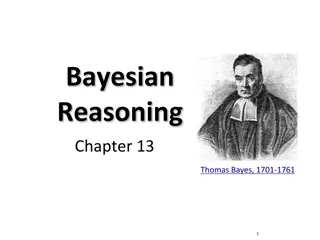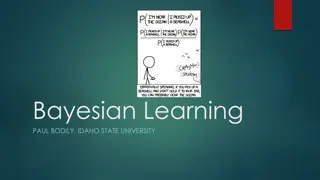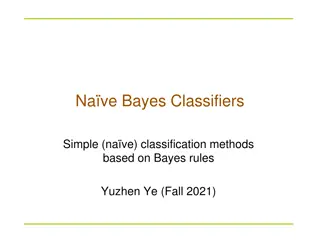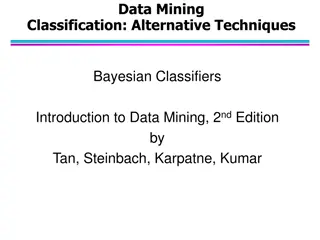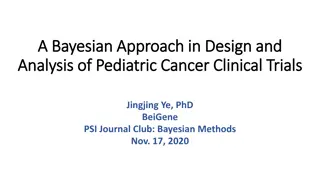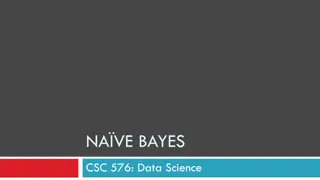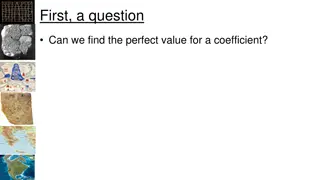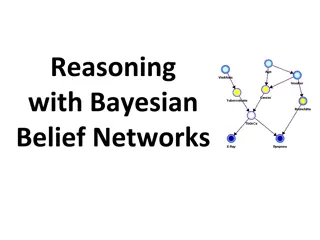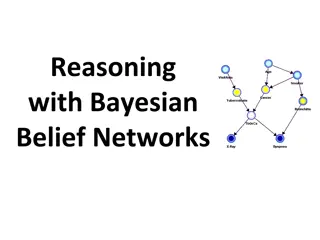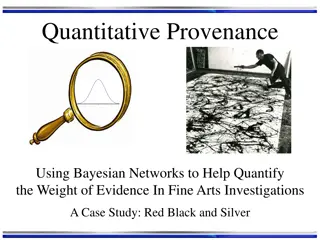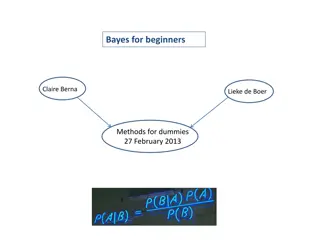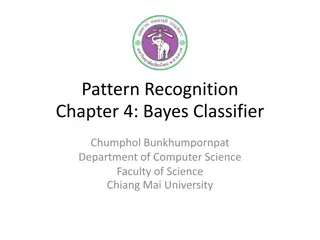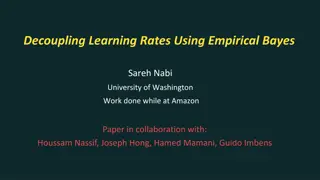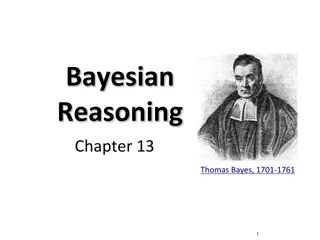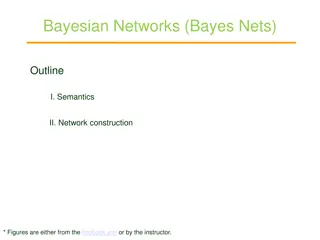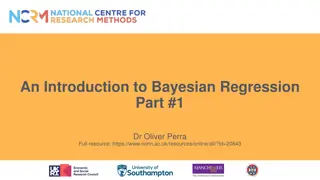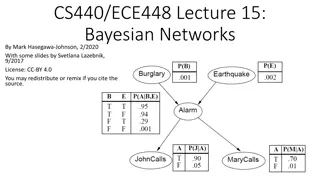Bayesian Meta-Prior Learning Using Empirical Bayes: A Framework for Sequential Decision Making Under Uncertainty
Explore the innovative framework proposed by Sareh Nabi at the University of Washington for Bayesian meta-prior learning using empirical Bayes. The framework aims to optimize ad layout and classification problems efficiently by decoupling learning rates of model parameters. Learn about the Multi-Armed Bandit algorithms, exploration vs. exploitation trade-offs, and the application of meta-prior learning in real-world scenarios.
- Bayesian Meta-Prior Learning
- Empirical Bayes
- Sequential Decision Making
- Multi-Armed Bandit
- Optimization
Download Presentation

Please find below an Image/Link to download the presentation.
The content on the website is provided AS IS for your information and personal use only. It may not be sold, licensed, or shared on other websites without obtaining consent from the author. Download presentation by click this link. If you encounter any issues during the download, it is possible that the publisher has removed the file from their server.
E N D
Presentation Transcript
Bayesian Meta-Prior Learning Using Empirical Bayes Sareh Nabi University of Washington Microsoft Dynamics Work started while intern at Amazon Paper in collaboration with: Houssam Nassif, Joseph Hong, Hamed Mamani, Guido Imbens
Sequential decision making under uncertainty
Exploration vs Exploitation Trade-off Explore/Learn Learn more about what is good and bad Exploit/Earn Make the best use of what we believe is good 3
Multi-armed Bandit (MAB) Originally proposed by Robbins (1952). Reward under arm i follows a Bernoulli dist. with unknown mean reward ? Goal: Pull arm sequentially to maximize total reward. 4
MAB Algorithms Algorithms that solve MAB problems Index policies: Gittin's index Frequentist approach: Upper Confidence Bound type algs Bayesian approach: challenge of non-informative prior 5
What we address Propose a framework to learn meta-prior from initial data using empirical Bayes Decouple learning rates of model parameters by grouping similar ones in the same category and learning their meta-prior separately Next: Overview of our meta-prior framework and its application to our ad layout optimization problem (in Amazon production system) and classification problem (on a public dataset). Lastly, review our theoretical results. 6
Biking competition Stop biking pointlessly, join team Circle! Year-round carousel rides! Unlimited laps! All you can eat Pi! No corners to hide! Hurry, don t linger around! Join now! Check other teams 7
Multiple-slot template Stop biking pointlessly, join team Circle! Slot Year-round carousel rides! Unlimited laps! All you can eat Pi! No corners to hide! Hurry, don t linger around! Join now! Check other teams 8
Template Combinatorics: 48 layouts Stop biking pointlessly, join team Circle! x2 x3 Best way to bicycle! We cycle and re-cycle! No point in not joining! x2 Join now! Check other teams x2 x2 9
Featurization First-order features, X1: variant values E.g. image1 , title2 , color1 Second-order features, X2: variant combinations/interactions E.g. image1 AND title2 , image1 AND color1 Concatenate for final feature vector representation: X = [X1, X2] 10
Generalized Linear Models (GLM) Assign one weight wi per feature xi Let r: reward (e.g. click), g: link function ? ? ? = ? 1(? ?) 1?? 1+ 2 ??? 2 ? ? = ?0+ ?? ??? ? ? ? intercept + 1st order + 2nd order effect 11
Bayesian GLM At time t, each weight wi is represented by a distribution: 2) ??,? ~ ?( ??,?, ??,? ? ? = ?2+ = ?1+ ?1 ?2 ???? Eg: ??????1 1 + ??????2 0 + + ??????3 0 + ??????1 1 + 12
Bayesian GLM weight updates wi,t update: + data = wi,t prior wi,t+1 posterior Starting prior: Non-informative standard normal ??,0 ?(0,1) Bayesian GLM bandits (Thompson Sampling): Sample W, thenargmax? ? 1(? ?) 13
Impose Bayesian hierarchy Let ??: true mean of weight ?? ??,?, ??,? 2: GLM-estimated mean and variance of weight ?? Critical model assumptions: Group features into Ck=2 categories (1st order, 2nd order) Each category ? has a hierarchical meta-prior ?(??,?? True mean ?? ? ??,?? Observed mean ??,?|?? ? ??, ??,? 2) 2, ? ?? 2, ?,? 15
Modelassumptions Meta prior ???~? ?2,?2 Meta prior 2, ? ?1 2, ?? ?2 ??~? ?1,?1 Empiric al prior helps, eve with one batch Type equation here. ?1,2, ?1,3, ?1, ?2, 2, ?,? ???,?|??? ? ???, ???,? 2 ??,?|?? ? ??, ??,? , ?,?,? 16
Empirical prior estimation Using variance decomposition & our assumptions: 2] 2 = ? ?? ?[ ?? ? Substituting empirical mean and variance estimators, 2 2 ? ?? ?? ? ?? 1 ? ?? ?? ?? ? ?? ?? ?? 2= ?? ; ?= 17
Empirical Bayes (EB) algorithm 1. Start Bayesian GLM with non-informative prior ?(0,1) 2. After time t, compute ??,?? for each category 3. Restart model with per-category empirical priors ?(??,?? 4. Retrain using data from elapsed t timesteps 5. Continue using GLM as normal 2) Algorithm used the same data twice, to compute the empirical prior and to train the model Works with online or batch settings 18
Experimental setup Used Bayesian Linear Probit (BLIP) as our Bayesian GLM Grouped features as 1st and 2nd order features batch updates Simulations on classification task (UCI income prediction) Live experiments in Amazon production system ?? had little effect, we focus on ?? 20
When to compute empirical prior Empirical prior helps, even with one batch Longer reset time helps more 21
Lasting effect on small batches BLIPBayes outperforms both other methods BLIPBayes can be especially valuable for small batch training 22
Empirical ? outperforms random ? Empirical Bayes did best Erring towards a large prior variance is more easily overcome by data than erring towards a small prior variance 23
Live experiment BLIP with Empirical Bayes meta-prior has higher success rate & converges faster 24
Theoretical Results Unbiasedness property of meta-prior variance estimator: 1 2- 2= k Nk (Nk 1) i,j Ck E ?? Cov( ??, ??) i j Our meta-prior variance estimator is strongly consistent when: i. Feature estimates ?? and their observed variances ?? ii. Expectation and variance exist for ??, ?? 2 are independent 2, and ?? 2. 3 2 Cumulative regret of our EB TS bandit is of order ?(? ?) 25
Takeaways Empirical Bayes prior helps, mostly on low/medium traffic Promising, as low traffic cases are harder to optimize Effectively decouples learning rates by imposing a Bayesian hierarchy and learning meta-prior per category of features Model converges faster with Empirical Bayes meta-prior Works for any feature grouping in a Bayesian setting Applies to contextual and personalization use cases 26
Paper is on arXiv: arxiv.org/abs/2002.01129 Slides available on my website. Feel free to reach out: Website: www.sarehnabi.com LinkedIn: www.linkedin.com/in/sarehnabi Twitter: twitter.com/SarehNabi Thank you! Any Questions? Comments? 27




